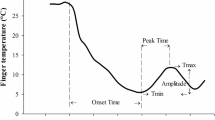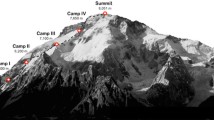Abstract
Cold-induced vasodilatation (CIVD) has been proposed as a potential protective mechanism against cold injuries during exposure of extremities to a cold environment. The purpose of this study was to evaluate the effect of exercise and the associated elevation in core temperature on toe skin temperatures during immersion of the foot in cold (8°C) water. Subjects (N = 8) participated in two trials. In one, they conducted an incremental exercise to exhaustion (exercise) on a cycle ergometer, which was followed by immersion of the right foot in 8°C water. In the second trial (control), immersion of the foot in cold water was not preceded by exercise. Upon completion of the exercise in the exercise trial, and at the onset of the immersion of the foot in cold water, tympanic temperature was 0.6°C (P < 0.01) higher than pre-exercise levels. There was a significant increase (P < 0.05) in the number of CIVD waves, but not their amplitudes, in the exercise trial compared to the control trial. A CIVD response occurred in 57.5% of all toes in the exercise trial, and in only 27.5% in the control trial. Additionally, 50% of subjects exhibited CIVD in at least one toe in the control trial, and 87.5% during the exercise trial. It is concluded that exercise, and particularly the associated elevation in core temperature, enhances the frequency of the toe CIVD responses, and can therefore potentially act as a protective mechanism against cold injury.



Similar content being viewed by others
References
Cheung SS, Mekjavic IB (2007) Cold-induced vasodilatation is not homogenous or generalizable across the hand and feet. Eur J Appl Physiol 99:701–705. doi:10.1007/s00421-006-0383-6
Daanen HA (2003) Finger cold-induced vasodilation: a review. Eur J Appl Physiol 89:411–426. doi:10.1007/s00421-003-0818-2
Daanen HA (2006) Infrared tympanic temperature and ear canal morphology. J Med Eng Technol 30:224–234. doi:10.1080/03091900600711613
Daanen HA (2009) Cold-induced vasodilatation. Eur J Appl Physiol 105:663–664. doi:10.1007/s00421-008-0958-5
Daanen HA, Ducharme MB (1999) Finger cold-induced vasodilation during mild hypothermia, hyperthermia and at thermoneutrality. Aviat Space Environ Med 70:1206–1210
Daanen HA, van der Struijs NR (2005) Resistance index of frostbite as a predictor of cold injury in arctic operations. Aviat Space Environ Med 76:1119–1122
Daanen HA, Van de Linde FJ, Romet TT, Ducharme MB (1997) The effect of body temperature on the hunting response of the middle finger skin temperature. Eur J Appl Physiol Occup Physiol 76:538–543. doi:10.1007/s004210050287
Francis TJ, Golden FS (1985) Non-freezing cold injury: the pathogenesis. J R Nav Med Serv 71:3–8
Francis TJR, Oakley EHN (1996) Cold injury. In: Tooke JE, Lowe GDO (eds) A textbook of vascular medicine. Arnold, London, pp 353–370
Flouris AD, Westwood DA, Mekjavic IB, Cheung SS (2008) Effect of body temperature on cold induced vasodilation. Eur J Appl Physiol 104:491–499. doi:10.1007/s00421-008-0798-3
Geurts CL, Sleivert GG, Cheung SS (2006) Local cold acclimation during exercise and its effect on neuromuscular function of the hand. Appl Physiol Nutr Metab 31:717–725. doi:10.1139/H06-076
Greenfield AD, Kernohan GA, Marshall RJ, Shepherd JT, Whelan RF (1951) Heat loss from toes and fore-feet during immersion in cold water. J Appl Physiol 4:37–45
Juopperi K, Hassi J, Ervasti O, Drebs A, Näyha S (2002) Incidence of frostbite and ambient temperature in Finland, 1986–1995. A national study based on hospital admissions. Int J Circumpolar Health 61:352–362
Lewis T (1930) Observations upon the reactions of the vessels of the human skin to cold. Heart 15:177–208
Mekjavic IB, Sun J, Lun V, Giesbrecht G (1992) Evaluation of an infra-red tympanic thermometer during cold water immersion and rewarming. In: Lotens W, Havenith G (eds) Proceedings of the 5th international conference on environmental ergonomics. Maastricht, The Netherlands, pp 42–43
Mekjavic IB, Kocjan N, Vrhovec M, Golja P, House C, Eiken O (2005) Foot temperatures and toe blood flow during a 12 km winter hike and guard duty. In: Prevention of cold injuries (pp. 5-1–5-4). Meeting proceedings RTO-MP-HFM-126, paper 5. RTO, Neuilly-sur-Seine. Available from: http://www.rto.nato.int/abstracts.asp
Mekjavic IB, Dobnikar U, Kounalakis SN, Musizza B, Cheung SS (2008) The trainability and contralateral response of cold-induced vasodilatation in the fingers following repeated cold exposure. Eur J Appl Physiol 104:193–199. doi:10.1007/s00421-008-0727-5
O’Brien C (2005) Reproducibility of the cold-induced vasodilation response in the human finger. J Appl Physiol 98:1334–1340. doi:10.1152/japplphysiol.00859.2004
O’Brien C, Montain SJ (2003) Hypohydration effect on finger skin temperature ad blood flow during cold-water finger immersion. J Appl Physiol 94:598–603. doi:10.1063/1.1574179
Romanovsky AA, Quint PA, Benikova Y, Kiesow LA (1997) A difference of 5°C between ear and rectal temperatures in febrile patient. Am J Emerg Med 15:383–385. doi:10.1016/S0735-6757(97)90133-9
Reynolds LF, Mekjavic IB, Cheung SS (2007) Cold-induced vasodilatation in the foot is not homogenous or trainable over repeated cold exposure. Eur J Appl Physiol 102:73–78. doi:10.1007/s00421-007-0566-9
Takano N, Kotani M (1989) Influence of food intake on cold-induced vasodilatation of finger. Jpn J Physiol 39:755–765. doi:10.2170/jjphysiol.39.755
Wilson O, Goldman RF (1970) Role of air temperature and wind in the time necessary for a finger to freeze. J Appl Physiol 29:658–664
Yoshimura H, Iida T (1952) Studies on the reactivity of skin vessels to extreme cold II. Factors governing the individual difference of the reactivity, or the resistance against frostbite. Jpn J Physiol 2:177–185
Acknowledgments
The authors wish to express their gratitude to the subjects for their participation. The study was supported, in part, by Knowledge for Security and Peace grant from the Ministries of Defense, and of Science (Republic of Slovenia).
Author information
Authors and Affiliations
Corresponding author
Rights and permissions
About this article
Cite this article
Dobnikar, U., Kounalakis, S.N. & Mekjavic, I.B. The effect of exercise-induced elevation in core temperature on cold-induced vasodilatation response in toes. Eur J Appl Physiol 106, 457–464 (2009). https://doi.org/10.1007/s00421-009-1035-4
Accepted:
Published:
Issue Date:
DOI: https://doi.org/10.1007/s00421-009-1035-4




